Wilhelmsbau museum Speyer
The Wilhelmsbau Museum
in Speyer, Germany
a new museum for self-playing musical
instruments
by Hauke Marxsen
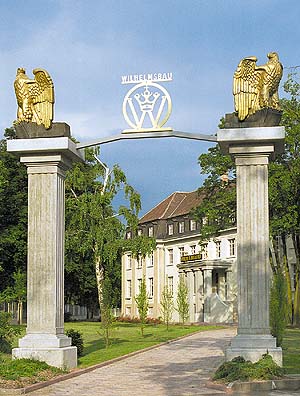 Speyer
is a romantic town on the river Rhine not far from Heidelberg. In the centre
you will find a big cathedral, and not far away (10 minutes to walk) you
reach the Technik Museum Speyer. It had a department for self-playing musical
instruments known under the name Musiksalon, which was closed for some
time and is now newly established in the Wilhelmsbau -- an outstanding
historical building and museum. Speyer
is a romantic town on the river Rhine not far from Heidelberg. In the centre
you will find a big cathedral, and not far away (10 minutes to walk) you
reach the Technik Museum Speyer. It had a department for self-playing musical
instruments known under the name Musiksalon, which was closed for some
time and is now newly established in the Wilhelmsbau -- an outstanding
historical building and museum.
The museum organizers thought, "The visitors want to see more, not only
some music boxes." So you will find the ambiance of the era of one
hundred years ago, with furniture, fashions, uniforms, accessory, old toys
and dolls. The Wilhelmsbau is a building with diversified history
dating from WW1. I estimate it has an exhibition area between 12,000
and 15,000 square feet in over three floors.
In the Internet you will find something about the Technik Museum at
http://www.technik-museum.de/.
The English version at http://www.technik-museum.de/home-wilhelmsbau/endex.html
is not yet up to date. In the German version the Wilhelmsbau is introduced
at http://www.technik-museum.de/home-wilhelmsbau/index.html
.
Hauke Marxsen
(Text condensed from
the museum catalog with the kind permission of Technik Museum Speyer)
(Click on the small image to view
a larger image.)
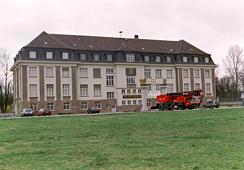 |
With the "Wilhelmsbau", situated in the grounds of the Technik
Museum Speyer just a few steps from the "Liller Halle" building, a unique
museum was created that takes visitors back to the turn of the century
era. The high, lavishly decorated rooms with their stucco ceilings, parquet
flooring and wainscoting are conveying an air of the glamour and noblesse
belonging to an epoch whose elegant lifestyle was material in forming our
picture of the "good old times". |
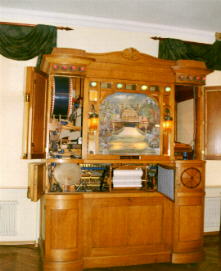 |
The spectrum of the exhibition shown on three levels is
truly outstanding. The main focus theme of the ground floor is a collection
of mechanized musical instruments. Long before the phonograph came into
existence these marvels of mechanized music, activated by cylinders, metal
plates or paper tapes, provided musical entertainment in cafes, restaurants
and drawing rooms of the middle classes.
The finest and most noble models, like the reproduction pianos by Messrs.
Welte of Freiburg, were reserved for a limited, privileged class of wealthy
music fans, who were able to enjoy concert hall quality performances of
the most famous pianists of their time with this instrument. To see and
hear one of these instruments in action is an unforgettable experience. |
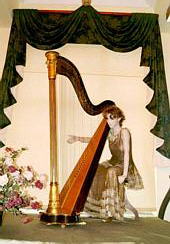 |
Then the imposing stairwell takes us up to the middle level
with an exhibition in painstakingly arranged display cases, each of them
a small time capsule in itself, showing historic fashion, contemporary
accessories, toys of the time and many items of everyday life of the middle
classes. Many of the fashion garments are draped on artists' dolls, 50
lifelike that you would expect to see them move around any moment.
Another highlight is the world-wide unique collection of dolls from
the United States comprising several thousand dolls of all periods and
styles, which are also on exhibit on the middle level of the museum. Classic
porcelain dolls are shown here as well as many characters from fairy tails
ranging from Cinderella to Alice in Wonderland. Particularly interesting
for hunters is the "Jagdzimmer", the Hunter's Room, which shows numerous
hunting trophies from all parts of the world. |
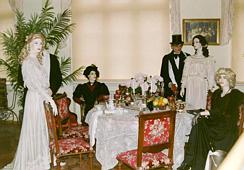 |
The tour of the building culminates in the Winkler collection
in the upper floor of the Wilhelmsbau. Exhibited in valuable, masterfully
illuminated mahogany show-cases, the glory of Old Prussia comes back to
life. Besides uniforms, helmets, medals and decorations, insignias, sabers
and other things military, the exhibition includes rare items of historic
fashion, reflecting the spirit of those times in a most impressive way. |
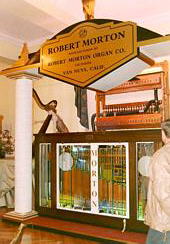 |
The Wilhelmsbau building houses one of the largest collection
of mechanized musical instruments, from the tiny musical box up to the
wardrobe-sized orchestrion. The range of instruments on exhibition is unique
and reaches from the beginning of music boxes, like the serinettes and
flue-work clocks of the late 18th century, up to the perfected reproduction
pianos and automatic violins of the nineteen-twenties. There is hardly
any other museum offering the visitors an opportunity to observe the technological
development of this singular class of instruments as closely as this. The
elaborately furnished rooms like the "Black Room" the "Room of Big
Organs", the "Clock Cabinet", and the "Hall of Orchestrions" not only lend
a particularly beautiful setting to the exhibition but also convey to the
visitor an impression of those times in which mechanized musical instruments
were at the height of their popularity. |
With the "Wilhelmsbau" building the collection of the Technik Museum
Speyer could he extended with many notable elements, and we hope that our
visitors will enjoy their tour of this exhibition as much as we did creating
and arranging the museum.
29 March 2000
|
 Gallery
Gallery
 Pictures
Pictures
 wilhelmsbau
wilhelmsbau
 Speyer
is a romantic town on the river Rhine not far from Heidelberg. In the centre
you will find a big cathedral, and not far away (10 minutes to walk) you
reach the Technik Museum Speyer. It had a department for self-playing musical
instruments known under the name Musiksalon, which was closed for some
time and is now newly established in the Wilhelmsbau -- an outstanding
historical building and museum.
Speyer
is a romantic town on the river Rhine not far from Heidelberg. In the centre
you will find a big cathedral, and not far away (10 minutes to walk) you
reach the Technik Museum Speyer. It had a department for self-playing musical
instruments known under the name Musiksalon, which was closed for some
time and is now newly established in the Wilhelmsbau -- an outstanding
historical building and museum.




